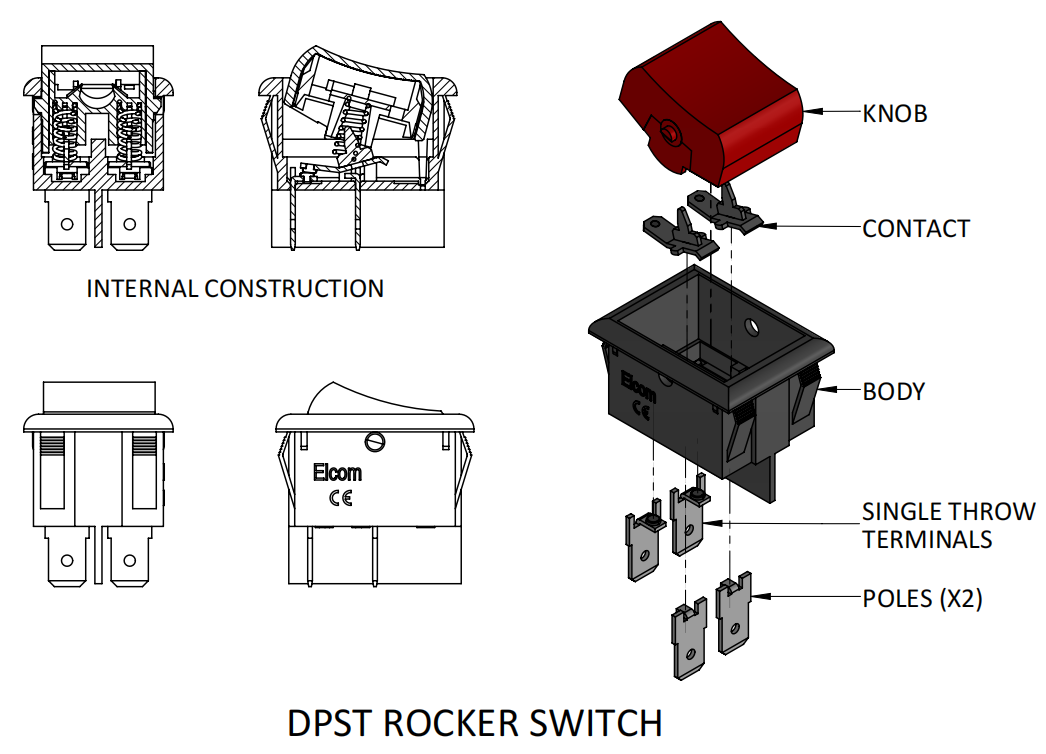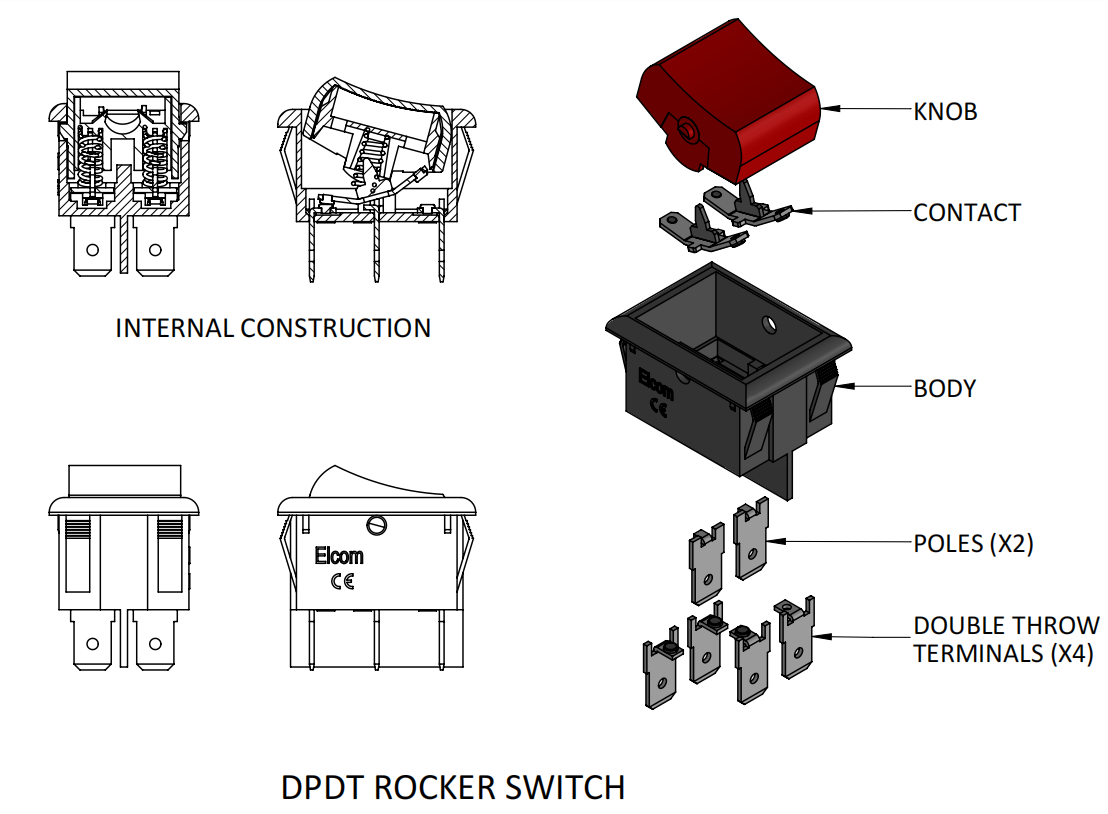Introduction
With an interesting history that goes back to the year 1884, electric switches have seen tremendous growth & development in designs, technologies, mechanisms & applications right from their introduction to date over the years. Used generally to manage the flow of current in the circuit, start & stop the flow on command, these electric switches come in varied sizes, shapes, designs & current magnitude to fit the requirements of applications & mechanisms. With ample types & options available to choose from based on the requirement; one general type of electric switch widely used & commonly applicable in almost every industry, personal, commercial, or industrial use are rocker switches. With demand in the uses of rocker switches, rocker switch manufacturers have also amplified their manufacturing meeting the growing requirements adhering to the varied specifications & mechanisms.
Also called Seesaw switches for their toggling characteristic, Rocker switches are commonly used to start or stop and On or Off the flow of current in the circuit with every push on either side. Rocker switches are often contradicted with a general toggle or trip switches. However, the major difference between toggle & rocker switches lies in the functionality where the toggle lifts the position when pressed but comes back to normal after release, Rockers just stay put in a tilt position until changed or pushed with external physical force.

Applications of a rocker switch :-
Acknowledged as one of the most common types of switches for its general use, these are extensively used for applications in devices. The On-Off switches used at home or office are mostly rocker switches with basic toggle type applications. It is easy to locate this electric switch integrated with circuits at various places like,
- Power outlet & supplies
- Control panels & sockets
- Household appliances
- Electric machinery
- Medical equipment
- Pumps & vehicles
Chosen precisely for its cost-effective & convenient feature it eases the overall operation. These switches are also designed with LED features to display the On & Off status of the circuit probably with differences in color.
How does a rocker switch work?
It is very easy to operate & use a rocker switch. It only requires pressure on either side of the switch to change the functionality from On to Off or Off to On. However, the upgrades in the designs by rocker switch manufacturers have also led to some complex structures used for specific mechanisms & applications.
Given the number of positions, rocker switches can be seen prone to temporary sticking between its general toggle-style. And to keep the function more smooth, the switches are designed with spring loading integration, which means that in case of uncertainty it will automatically return to the neutral position even without being pressed. Its simple designed structure makes it easy to augment the structure with advanced features. Adding indicative lighting being the one, there are several ways to engineer the design as per the requirements.
A simple breakthrough of the structure that makes this type of rocker switches work helps with a better understanding of the mechanism.

Most of these switches are designed to manage & control relatively simple circuits through physical command. Given the increase in the specifications, mechanisms & configurations; the switches are designed to control through different positioning in complex ways.
It is important to take care of the circuit by using a systematic integration of the electric switch with perfectly maintained configuration. Using switches that maintain the safety of the circuit along with maintaining the optimum flow of current is of utmost importance. At Elcom International, Leading rocker switch manufacturers in India along with manufacturing & supplying electrical switches takes care of the industry standards & manufactures the appliances that adhere to the mechanism & configuration. With the best quality switches, at Elcom International, we aim towards creating value for all our customers with innovative high technology & trusted quality electronic components & products.
The four most common types of switches in circuit design are:
- Single Pole Single Throw (SPST)
- Single Pole Double Throw (SPDT)
- Double Pole Single Throw (DPST)
- Double Pole Double Throw (DPDT)
Every type of rocker switch has two main components that control the circuit; a switch pole and a switch throw.
- Switch Pole:- refers to the number of circuits controlled by the switch: SP switches control only one electrical circuit. DP switches control two independent circuits (and act like two identical switches that are mechanically linked). Do not confuse ‘pole’ with ‘terminal’. The DPST switch, for example, has four terminals, but it is a DP, not a 4P switch.
- Switch Throw :- refers to the extreme position of the actuator: ST switches close a circuit at only one position. The other position of the handle is Off. DT switches close a circuit in the Up position, as well as the Down position (On-On). A DT switch can also have a center position (frequently On-Off-On).
Types of Rocker Switches and its construction :-
1.SPST: Single pole Single throw :-
A Single Pole Single Throw (SPST) switch is a switch that only has a single input and can connect only to one output. This means it only has one input terminal and only one output terminal.
A Single Pole Single Throw switch serves in circuits as on-off switches. When the switch is closed, the circuit is on. When the switch is open, the circuit is off. SPST switches are, thus, very simple in nature.
2.SPDT: Single pole double throw :-
A Single Pole Double Throw (SPDT) switch is a switch that only has a single input and can connect to and switch between the 2 outputs. This means it has one input terminal and two output terminals. A Single Pole Double Throw switch can be used for a variety of functions in a circuit. It can serve as an on-off switch, depending on how the circuit is wired. Or it can serve to connect circuits to any 2 various paths that a circuit may need to function in.
3. DPST – double pole single throw :-
A Double Pole Single Throw (DPST) switch is a switch that has two inputs and two outputs; each input has a single corresponding output. Each of the terminals of a double pole single switch can either be in the on position (closed) or in the off position (open).

A Double Pole Single Switch has a lot of versatility being that it accepts double inputs, which makes it then be able to drive two different outputs in a circuit. What it drives depends on the circuit design and what the circuit is intended to do. But DPST has enormous applications in circuits.
4. DPDT – double pole double throw :-
A Double Pole Double Throw (DPDT) switch consists of six terminals, two of which are independent input terminals. Each of the poles can complete two different circuits. In other words, each input terminal connects with two output terminals, and all four output terminals are separate. DPDT switches are the most advanced type of switch.

